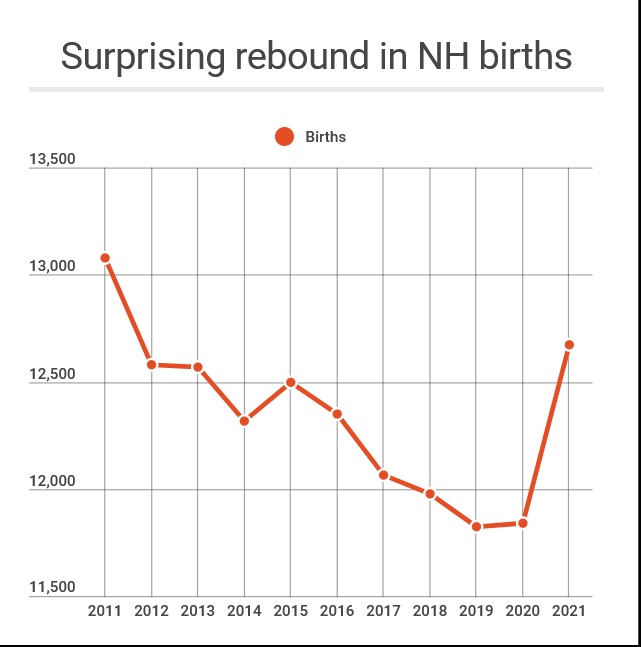After years and years of declining birth rates, New Hampshire has surprised just about everybody by seeing the country’s biggest baby boom last year with a birth rate that rebounded 7% since pre-pandemic times, far more than any other state.
Whether it will continue remains to be seen.
According to state data, 12,670 infants arrived in Granite State birthing rooms in 2021. That’s the biggest such jump of any state in the nation since 2019, even more than baby-happy places like Utah, according to Stateline, a news service run by Pew Charitable Trusts.

Such a two-year jump by percentage is rare, according to the state’s historic data. In absolute numbers the increase is pretty big, too: The last time so many babies were born here, John Lynch was governor.
This “boomlet” is surprising because economic disruption usually sends birth rates plummeting as people delay having families. That is what happened in most of the country, with 37 states seeing birth rates fall between 2019 and 2021.
New Hampshire, as well as the rest of New England, were an exception: All six of the region’s states saw birth rates rise since 2019. It’s not entirely clear why.
The New Hampshire boost was “driven almost completely by women … in their early 30s with a college degree,” according to Stateline.
The question is whether most of those new parents were state residents who were planning to have the baby one day and who decided that the disruption of the pandemic gave them the time they didn’t have before the economy shut down.
If that’s what happened then the state could be set up for a future demographic lurch – we’ll see fewer births in coming years than expected since they will have already happened.
Another possibility is that we’re seeing the result of a trend known as in-migration, which UNH demographer Ken Johnson says has been the only thing keeping our population from sinking. (Total deaths in New Hampshire have outpaced total births for at least two years.)
It might be that young adults moving to the state for jobs and housing that’s less expensive than in Massachusetts – a trend that increased when the pandemic hit – have started having families. If that’s the case, we can expect to see our baby boomlet continue for at least the foreseeable future.
Whatever the reason, the news is being celebrated because New Hampshire has long bemoaned our aging population. For decades we’ve watched a long, slow decline in babies that has led several hospitals to shut their birthing centers due to lack of business.
The number of annual births in New Hampshire has fallen almost every year since the late 20th century, slipping slowly and inexorably from 14,054 in 2001 to 13,080 in 2011 to just 11,840 in 2020.
The decline has been so great that even last year’s historic jump can’t overcome it. We are still 10% below the birth rate we saw at the turn of the millennium.
This makes us part of a northern New England trend – only Maine and Vermont rival us in average age – and a national trend. Non-Hispanic whites have been choosing to have smaller and smaller families for many years and northern New England is just about the whitest place in the country.
Whatever the reason, one thing seems clear: kindergarten is going to be crowded in five years.

 Return to the Concord Monitor
Return to the Concord Monitor